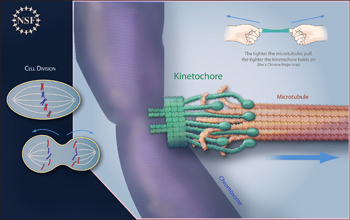Multimedia Gallery
During cell division, the kinetochore and microtubule pull chromosome copies away from each other.
During cell division, a huge molecular complex called the kinetochore and a microtubule attach themselves to each chromosome and pull to create two daughter cells. Researchers have recently isolated the kinetochore outside of the cell, and have been able to demonstrate its functions in vitro. Surprisingly, the more tension there is on the microtubule, the more stable the connection to the kinetochore, analogous to how a Chinese finger trap ensnares a finger tighter as one tries to pull it off harder and harder.
Credit: Zina Deretsky, National Science Foundation
Images credited to the National Science Foundation, a federal agency, are in the public domain. The images were created by employees of the United States Government as part of their official duties or prepared by contractors as "works for hire" for NSF. You may freely use NSF-credited images and, at your discretion, credit NSF with a "Courtesy: National Science Foundation" notation.
Additional information about general usage can be found in Conditions.
Also Available:
Download the high-resolution JPG version of the image. (563 KB)
Use your mouse to right-click (Mac users may need to Ctrl-click) the link above and choose the option that will save the file or target to your computer.
Related story: Getting a Tighter Grip on Cell Division



